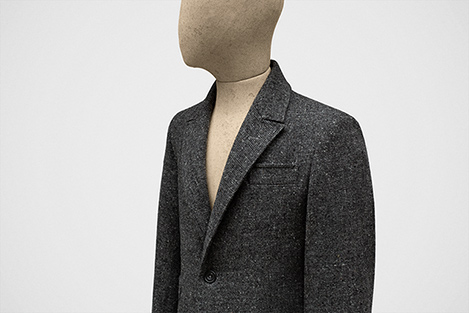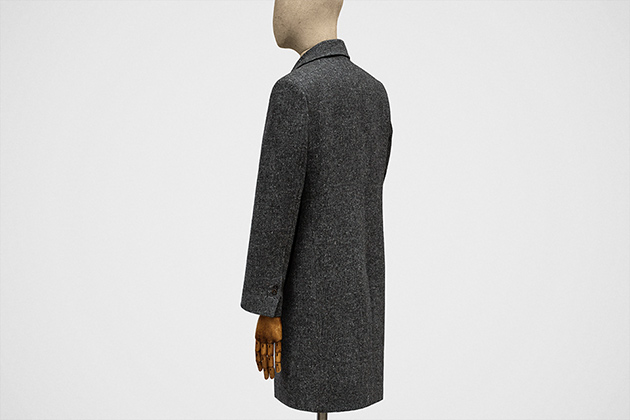The topcoat is a smart, single-breasted overcoat, cut much in the manner of a tailored jacket but far, far longer. Notable is the position of its break — which is to say, the point to which it fastens — which is much lower, and thus simultaneously more relaxed and more elegant, than a typical tailored overcoat.
The topcoat has a lapel of moderate width, but which interestingly looks more narrow than it is on account of the aforementioned lowness of the fastening point. There is a barely-there peak on the lapel, and the gap between the lapel and the collar is drawn closed with fine hand-stitching.
The shoulders of the topcoat are very, very lightly padded, bringing shape and smartness to the silhouette of the body.
There are four pockets on the outside of the coat. Two of them are large and sit at the waist, and are covered by flaps. Then there's the smaller ticket pocket and even smaller chest pocket, both of which are covered by somewhat unorthodox upturned flaps — reflections or echoes, in a way, of the two larger pockets.
The buttons on the coat are horn, and are dark matte tortoiseshell in colour. Being as they are an entirely natural thing, each looks different to the next, varying in tone and hue and striatic markings.
There are three buttons at the cuff, with the buttonholes cut open. It is a working cuff, in other words, though has no quarrel whatsoever with cuffs that cannot work or do not work.
A deep vent runs up the back of the topcoat, helping it swing around nicely when worn; fanning out gracefully over, say, a chair, so as to never risk plonking your posterior down on the back of the coat; and easing times exponential the experience of wearing the coat when climbing into a car.
The topcoat has an in-breast pocket — an internal chest pocket, that is, of the jetted variety — on both the left and right sides. Meanwhile, the coat is fully lined with a slinky, lightweight satin, making donning and undonning it a breeze, and helping to reduce friction with whatever is worn underneath.
The cloth is chunky box tweed, Donegal writ through. The yarn — a warp of charcoal and a weft of mid-grey — is alive with little flecks of unexpected shades, from auburn to chalk to chocolate. It is merino lambswool, softer than one might assume, and fairs mightily well in the wet and the windy.




























